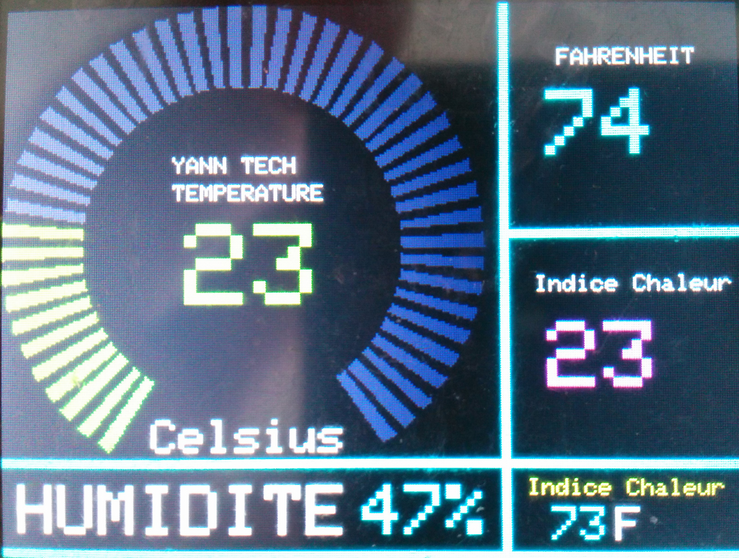Afficher/cacher Sommaire
Arduino UNO + Ecran tactile 2.4” TFT
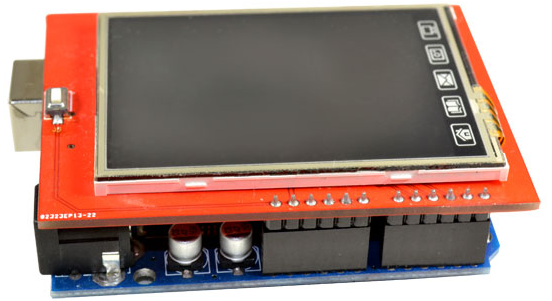
Description
Le shield Arduino 2.4 “TFT LCD tactile
2.4 inch lcd for arduino uno or mage2560 solution:320x240 ic: ili9325 ili9340
Ce shield est compatible avec Arduino UNO / Mega et possède un écran tactile et un lecteur de carte SD
Caractéristiques techniques
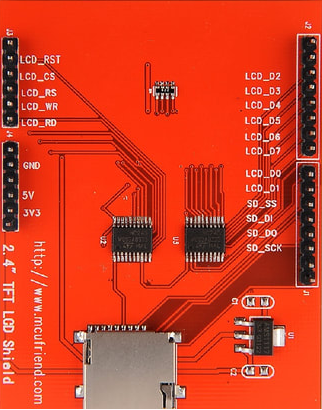
- Écran LCD TFT 2.4” à résolution 320 x 240
- Compatible avec des niveaux de tension de fonctionnement de 3,3 et 5 V
- Inclut l’écran tactile et le port de la carte SD
- Contrôleur d’affichage : ST7783
- Identifiant: 0x7783
Utiliser le TFT avec Arduino UNO
- How to Use 2.4 Inch TFT LCD SPFD5408 With Arduino Uno and Mega
- Librairie SPFD5408
- Ecran tactile 2.8” TFT
- Lire et écrire des données sur une carte SD avec une carte Arduino / Genuino
- How to check TFT lcd driver?
Charger la librairie

diagnostique : diagnose_TFT_support
#include <MCUFRIEND_kbv.h>
MCUFRIEND_kbv tft;
// Assign human-readable names to some common 16-bit color values:
#define BLACK 0x0000
#define BLUE 0x001F
#define RED 0xF800
#define GREEN 0x07E0
#define CYAN 0x07FF
#define MAGENTA 0xF81F
#define YELLOW 0xFFE0
#define WHITE 0xFFFF
#define GRAY 0x8410
uint16_t version = MCUFRIEND_KBV_H_;
void setup()
{
Serial.begin(9600);
if (!Serial) delay(5000); //allow some time for Leonardo
uint16_t ID = tft.readID(); //
Serial.println(F("Diagnose whether this controller is supported"));
Serial.println(F("There are FAQs in extras/mcufriend_how_to.txt"));
Serial.println(F(""));
Serial.print(F("tft.readID() finds: ID = 0x"));
Serial.println(ID, HEX);
Serial.println(F(""));
Serial.print(F("MCUFRIEND_kbv version: "));
Serial.print(version/100);
Serial.print(F("."));
Serial.print((version / 10) % 10);
Serial.print(F("."));
Serial.println(version % 10);
Serial.println(F(""));
if (ID == 0x0404) {
Serial.println(F("Probably a write-only Mega2560 Shield"));
Serial.println(F("#define USE_SPECIAL in mcufriend_shield.h"));
Serial.println(F("#define appropriate SPECIAL in mcufriend_special.h"));
Serial.println(F("e.g. USE_MEGA_16BIT_SHIELD"));
Serial.println(F("e.g. USE_MEGA_8BIT_SHIELD"));
Serial.println(F("Hint. A Mega2560 Shield has a 18x2 male header"));
Serial.println(F("Often a row of resistor-packs near the 18x2"));
Serial.println(F("RP1-RP7 implies 16-bit but it might be 8-bit"));
Serial.println(F("RP1-RP4 or RP1-RP5 can only be 8-bit"));
}
if (ID == 0xD3D3) {
uint16_t guess_ID = 0x9481; // write-only shield
Serial.println(F("Probably a write-only Mega2560 Shield"));
Serial.print(F("Try to force ID = 0x"));
Serial.println(guess_ID, HEX);
tft.begin(guess_ID);
}
else tft.begin(ID);
Serial.println(F(""));
if (tft.width() == 0) {
Serial.println(F("This ID is not supported"));
Serial.println(F("look up ID in extras/mcufriend_how_to.txt"));
Serial.println(F("you may need to edit MCUFRIEND_kbv.cpp"));
Serial.println(F("to enable support for this ID"));
Serial.println(F("e.g. #define SUPPORT_8347D"));
Serial.println(F(""));
Serial.println(F("New controllers appear on Ebay often"));
Serial.println(F("If your ID is not supported"));
Serial.println(F("run LCD_ID_readreg.ino from examples/"));
Serial.println(F("Copy-Paste the output from the Serial Terminal"));
Serial.println(F("to a message in Displays topic on Arduino Forum"));
Serial.println(F("or to Issues on GitHub"));
Serial.println(F(""));
Serial.println(F("Note that OPEN-SMART boards have diff pinout"));
Serial.println(F("Edit the pin defines in LCD_ID_readreg to match"));
Serial.println(F("Edit mcufiend_shield.h for USE_SPECIAL"));
Serial.println(F("Edit mcufiend_special.h for USE_OPENSMART_SHIELD_PINOUT"));
while (1); //just die
} else {
Serial.print(F("PORTRAIT is "));
Serial.print(tft.width());
Serial.print(F(" x "));
Serial.println(tft.height());
Serial.println(F(""));
Serial.println(F("Run the examples/graphictest_kbv sketch"));
Serial.println(F("All colours, text, directions, rotations, scrolls"));
Serial.println(F("should work. If there is a problem, make notes on paper"));
Serial.println(F("Post accurate description of problem to Forum"));
Serial.println(F("Or post a link to a video (or photos)"));
Serial.println(F(""));
Serial.println(F("I rely on good information from remote users"));
}
}
void loop()
{
static uint8_t aspect = 0;
const char *aspectname[] = {
"PORTRAIT", "LANDSCAPE", "PORTRAIT_REV", "LANDSCAPE_REV"
};
const char *colorname[] = { "BLUE", "GREEN", "RED", "GRAY" };
uint16_t colormask[] = { BLUE, GREEN, RED, GRAY };
uint16_t ID = tft.readID(); //
tft.setRotation(aspect);
int width = tft.width();
int height = tft.height();
tft.fillScreen(colormask[aspect]);
tft.drawRect(0, 0, width, height, WHITE);
tft.drawRect(32, 32, width - 64, height - 64, WHITE);
tft.setTextSize(2);
tft.setTextColor(BLACK);
tft.setCursor(40, 40);
tft.print("ID=0x");
tft.print(ID, HEX);
if (ID == 0xD3D3) tft.print(" w/o");
tft.setCursor(40, 70);
tft.print(aspectname[aspect]);
tft.setCursor(40, 100);
tft.print(width);
tft.print(" x ");
tft.print(height);
tft.setTextColor(WHITE);
tft.setCursor(40, 130);
tft.print(colorname[aspect]);
tft.setCursor(40, 160);
tft.setTextSize(1);
tft.print("MCUFRIEND_KBV_H_ = ");
tft.print(version);
if (++aspect > 3) aspect = 0;
delay(5000);
}
Résultat afficher dans la console (Outils → Moniteur Série)

Test afficheur testcard_kbv
/*
* generate testcard similar to BMP
*/
#include <Adafruit_GFX.h>
#if defined(_GFXFONT_H_) //are we using the new library?
#include <Fonts/FreeSans9pt7b.h>
#define ADJ_BASELINE 11 //new fonts setCursor to bottom of letter
#else
#define ADJ_BASELINE 0 //legacy setCursor to top of letter
#endif
#include <MCUFRIEND_kbv.h>
MCUFRIEND_kbv tft;
#define BLACK 0x0000
#define BLUE 0x001F
#define RED 0xF800
#define GREEN 0x07E0
#define CYAN 0x07FF
#define MAGENTA 0xF81F
#define YELLOW 0xFFE0
#define WHITE 0xFFFF
#define RGB(r, g, b) (((r&0xF8)<<8)|((g&0xFC)<<3)|(b>>3))
#define GREY RGB(127, 127, 127)
#define DARKGREY RGB(64, 64, 64)
#define TURQUOISE RGB(0, 128, 128)
#define PINK RGB(255, 128, 192)
#define OLIVE RGB(128, 128, 0)
#define PURPLE RGB(128, 0, 128)
#define AZURE RGB(0, 128, 255)
#define ORANGE RGB(255,128,64)
#include <stdio.h>
uint16_t ID;
uint8_t hh, mm, ss; //containers for current time
uint8_t conv2d(const char* p)
{
uint8_t v = 0;
if ('0' <= *p && *p <= '9') v = *p - '0';
return 10 * v + *++p - '0';
}
void setup(void)
{
Serial.begin(9600);
tft.reset();
ID = tft.readID();
Serial.print("TFT ID = 0x");
Serial.println(ID, HEX);
// if (ID == 0xD3D3) ID = 0x9481; // write-only shield
if (ID == 0xD3D3) ID = 0x9486; // write-only shield
tft.begin(ID);
tft.setRotation(1);
tft.fillScreen(BLACK);
#if defined(_GFXFONT_H_)
tft.setFont(&FreeSans9pt7b);
#endif
hh = conv2d(__TIME__);
mm = conv2d(__TIME__ + 3);
ss = conv2d(__TIME__ + 6);
}
void loop(void)
{
int16_t x, y, dx, dy, radius = 108, idx;
uint16_t w, h, len, mask;
uint16_t colors[8] = { BLACK, WHITE, YELLOW, CYAN, GREEN, MAGENTA, RED, BLUE };
uint16_t height, width;
width = tft.width();
height = tft.height();
tft.fillRect(0, 0, 7, 3, WHITE);
tft.fillRect(313, 0, 7, 3, WHITE);
tft.fillRect(0, 237, 7, 3, WHITE);
tft.fillRect(313, 237, 7, 3, WHITE);
for (y = 0, w = 18, h = 3; y < 240; y += 13 * w + h) {
for (x = 25; x < 320 - 18; x += 2 * w) {
tft.fillRect(x, y, w, h, WHITE);
}
}
for (x = 0, w = 7, h = 18; x < 320; x += 17 * h + w) {
for (y = 21; y < 240 - 18; y += 2 * h) {
tft.fillRect(x, y, w, h, WHITE);
}
}
tft.fillRect(7, 3, 17 * 18, 13 * 18, GREY);
for (x = 7, y = 0, w = 1, h = 240; x < 320; x += 18) {
tft.fillRect(x, y, w, h, WHITE);
}
for (x = 0, y = 3, w = 320, h = 1; y < 240; y += 18) {
tft.fillRect(x, y, w, h, WHITE);
}
tft.fillRect(26, 22, 17, 99, TURQUOISE);
tft.fillRect(26, 120, 17, 99, PINK);
tft.fillRect(44, 22, 17, 35, AZURE);
tft.fillRect(44, 184, 17, 35, ORANGE);
tft.fillRect(260, 22, 17, 35, AZURE);
tft.fillRect(260, 184, 17, 35, ORANGE);
tft.fillRect(278, 22, 17, 99, OLIVE);
tft.fillRect(278, 120, 17, 99, PURPLE);
for (dx = radius; dx > -radius; dx--) {
w = sqrt(radius * radius - dx * dx);
y = 120 - dx;
dy = (y - 3) / 18;
mask = 7;
colors[0] = (dy == 3) ? DARKGREY : BLACK;
switch (dy) {
case 0:
case 1: idx = 1; len = 0; break;
case 2: idx = 0; len = 0; break;
case 3: idx = 0; len = 13; mask = 1; break;
case 4:
case 5: idx = 2; len = 38; break;
case 6:
case 7:
case 8: idx = 0; len = 0; break;
case 9: for (idx = 2; idx < 8; idx++) {
//dy = 0xFF >> (7 - idx);
dy = (idx - 2) * 51;
colors[idx] = tft.color565(dy, dy, dy);
}
idx = 2; len = 38; break;
case 10: idx = 1; len = 0; break;
case 11:
case 12: colors[2] = YELLOW; idx = 2; len = 0; break;
}
if (len == 0)
tft.fillRect(160 - w, y, w * 2, 1, colors[idx]);
else {
if (mask == 1) idx = 1 + (w) / len;
dy = w % len;
for (x = 160 - w; x < 160 + w; idx++) {
tft.fillRect(x, y, dy, 1, colors[idx & mask]);
x += dy;
if (x + len > 160 + w) dy = w % len;
else dy = len;
}
}
}
for (x = 72, y = 129, dx = 5, dy = 0; dx > 0; x += 2 * dx) {
tft.fillRect(x, y, dx, 36, WHITE);
dy += dx * 2;
if (dy >= 36) {
dy = 0;
dx--;
}
}
tft.fillRect(160 - 8, 5 * 18 + 3, 17, 3 * 18, BLACK);
for (x = 3 * 18 + 7, y = 6 * 18 + 3, w = 1, h = 18; x < 160 + 108; x += 18) {
tft.fillRect(x, y, w, h, WHITE);
}
tft.fillRect(160 - 108, 120, 108 * 2, 1, WHITE);
tft.fillRect(160, 5 * 18 + 3, 1, 3 * 18, WHITE);
tft.fillRect(108, 2 * 18 + 3, 6 * 18, 18, WHITE);
// tft.fillRect(108, 10 * 18 + 3, 6 * 18, 18, BLACK);
tft.fillRect(160 - 8, 11 * 18 + 3, 17, radius - 18*9/2, RED);
tft.setCursor(160 - 36, 24 + ADJ_BASELINE);
tft.setTextColor(BLACK);
tft.setTextSize(1);
tft.print("320x240");
tft.setCursor(109, 43 + ADJ_BASELINE);
tft.setTextColor(BLACK);
tft.setTextSize(1);
tft.print("ID=0x");
tft.print(tft.readID(), HEX);
tft.setTextColor(WHITE, BLACK);
// tft.setFont(NULL);
// tft.setTextSize(2);
while (1) {
if (++ss > 59) {
ss = 0;
mm++;
if (mm > 59) {
mm = 0;
hh++;
if (hh > 23) hh = 0;
}
}
char buf[20];
sprintf(buf, "%02d:%02d:%02d", hh, mm, ss);
tft.fillRect(108, 10 * 18 + 3, 6 * 18, 18, BLACK);
tft.setCursor(128, 187 + ADJ_BASELINE);
tft.print(buf);
delay(1000);
}
}
Résultat afficher dans la console (Outils → Moniteur Série)

Test graphique graphictest_kbv
Test de calibration TouchScreen_Calibr_Native
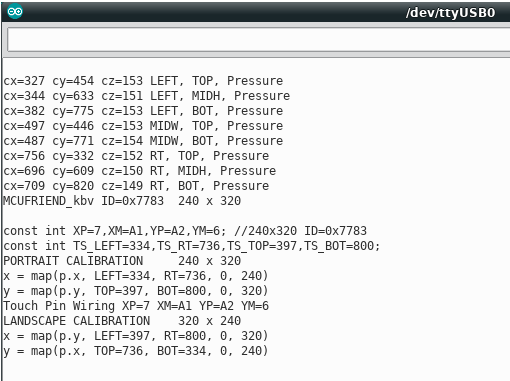
Capteur + moniteur écran TFT 320x200
Le capteur DHT22/AM2302
Le capteur de température et humidité DHT22/AM2302 (Documentation (pdf))
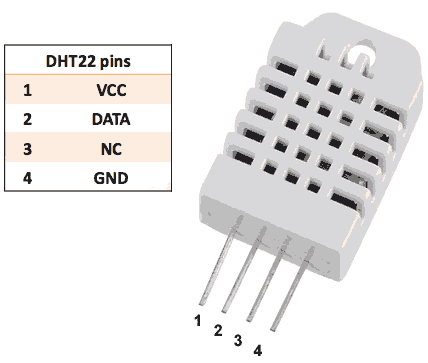

Le programme
Le capteur DHT22/AM2302 est connecté sur 19 repéré A5 sur carte arduino UNO
Le croquis Monitor-LCD-Hum-Temp.ino dans le dossier ~/Arduino/Monitor-LCD-Hum-Temp/
/*
Moniteur de température et humidité
*/
// *** Define Pin of LCD used
#define LCD_CS A3 // Chip Select goes to Analog 3
#define LCD_CD A2 // Command/Data goes to Analog 2
#define LCD_WR A1 // LCD Write goes to Analog 1
#define LCD_RD A0 // LCD Read goes to Analog 0
#define LCD_RESET A4 // Can alternately just connect to Arduino's reset pin
#include <SPI.h> // f.k. for Arduino-1.5.2
#include "Adafruit_GFX.h"// Hardware-specific library
#include <MCUFRIEND_kbv.h>
//#include <Adafruit_TFTLCD.h>
//Adafruit_TFTLCD tft(LCD_CS, LCD_CD, LCD_WR, LCD_RD, LCD_RESET);
// Assign human-readable names to some common 16-bit color values:
#define BLACK 0x0000
#define BLUE 0x001F
#define RED 0xF800
#define GREEN 0x07E0
#define CYAN 0x07FF
#define MAGENTA 0xF81F
#define YELLOW 0xFFE0
#define WHITE 0xFFFF
#define GREY 0x2108
#include "DHT.h"
#define DHTPIN 19 // broche ou l'on a branche le capteur
#define DHTTYPE DHT22 // DHT 22 (AM2302)
DHT dht(DHTPIN, DHTTYPE); //déclaration du capteur
// *** Define Touchscreen Pin
#define YP A2
#define XM A1
#define YM 6
#define XP 7
// *** Define Value of Touchscreen input
#define TS_MINX 150
#define TS_MINY 120
#define TS_MAXX 920
#define TS_MAXY 940
#include "TouchScreen_kbv.h"
TouchScreen_kbv ts(XP, YP, XM, YM, 300);
//Adafruit_TFTLCD tft(LCD_CS, LCD_CD, LCD_WR, LCD_RD, LCD_RESET);
MCUFRIEND_kbv tft;
#define MINPRESSURE 10
#define MAXPRESSURE 1000
// Meter colour schemes
#define RED2RED 0
#define GREEN2GREEN 1
#define BLUE2BLUE 2
#define BLUE2RED 3
#define GREEN2RED 4
#define RED2GREEN 5
uint32_t runTime = -99999; // time for next update
int reading = 0; // Value to be displayed
int d = 0; // Variable used for the sinewave test waveform
boolean alert = 0;
int8_t ramp = 1;
int tesmod =0;
void setup() {
dht.begin(); // démarrage capteur
tft.reset(); //Reset LCD to begin
tft.begin(0x7783);
tft.setRotation(1); // Set Rotation at 0 degress (default)
tft.fillScreen(BLACK); //Set Background Color with BLACK
tft.setCursor (7,208);
tft.setTextSize (3);
tft.setTextColor (WHITE,BLACK);
tft.print ("HUMIDITE");
tft.setCursor (75,78);
tft.setTextSize (1);
tft.setTextColor (WHITE,BLACK);
tft.print ("TEMPERATURE");
tft.setCursor (75,66);
tft.setTextSize (1);
tft.setTextColor (WHITE,BLACK);
tft.print ("YANN TECH");
tft.setCursor (242,20);
tft.setTextSize (1);
tft.setTextColor (WHITE,BLACK);
tft.print ("FAHRENHEIT");
tft.setCursor (232,118);//heat index celsius
tft.setTextSize (1);
tft.setTextColor (WHITE,BLACK);
tft.print ("Indice Chaleur");
tft.setCursor (228,205);//heat index fahrenheit
tft.setTextSize (1);
tft.setTextColor (YELLOW,BLACK);
tft.print ("Indice Chaleur");
tft.setCursor (265,217);//Small fahrenheit text
tft.setTextSize (2);
tft.setTextColor (WHITE,BLACK);
tft.print ("F");
//Design Interface (lines)
tft.fillRect(0,197,320,4,CYAN);
tft.fillRect(0,236,320,4,CYAN);
tft.fillRect(217,0,4,240,CYAN);
tft.fillRect(217,98,320,4,CYAN);
}
void loop() {
// La lecture du capteur prend 250ms
// Les valeurs lues peuvet etre vieilles de jusqu'a 2 secondes (le capteur est lent)
float h = dht.readHumidity(); //on lit l'hygrometrie
float t = dht.readTemperature(); //on lit la temperature en celsius (par defaut)
float f = dht.readTemperature(true); // pour lire en farenheit, il faut le paramère (isFahrenheit = true)
// Heat Index ou Indice de chaleur
// L’ indice de chaleur (ou humidex) ou est calculé en fonction de la température et de l’humidité extérieures
// le plus souvent exprimé en C° (même si c’est une valeur qui devrait, selon la formule, ne pas avoir d’unité)
// Calcul de l'indice de chaleur en Farenheit (par défaut)
float hif = dht.computeHeatIndex(f, h);
// Calcul de l'indice de chaleur en Celsius (isFahreheit = false)
float hic = dht.computeHeatIndex(t, h, false);
if (millis() - runTime >= 500) { // Exécution tous les 500ms
runTime = millis();
if(tesmod==0){reading=99; }
if(tesmod==1){reading = t;}
int xpos = 0, ypos = 5, gap = 4, radius = 52;
// Draw a large meter
xpos = 320/2 - 160, ypos = 0, gap = 100, radius = 105;
ringMeter(reading,0,100, xpos,ypos,radius,"Celsius",GREEN2RED); // Draw analogue meter
if(h>0){ //Humidity %
tft.setCursor (157,208);
tft.setTextSize (3);
tft.setTextColor (CYAN,BLACK);
tft.print (h,0); tft.print ('%');
tesmod=1;
}
if(f>0){ //Fahrenheit
tft.setCursor (237,38);
tft.setTextSize (4);
tft.setTextColor (CYAN,BLACK);
tft.print (f,0);
tesmod=1;
}
if(hif>0){ //Heat index Fahrenheit
tft.setCursor (238,217);
tft.setTextSize (2);
tft.setTextColor (CYAN,BLACK);
tft.print (hif,0);
tesmod=1;
}
if(hic>0){ //Heat index Celsius
tft.setCursor (237,138);
tft.setTextSize (4);
tft.setTextColor (MAGENTA,BLACK);
tft.print (hic,0);
tesmod=1;
}
}
}
// #########################################################################
// Draw the meter on the screen, returns x coord of righthand side
// #########################################################################
int ringMeter(int value, int vmin, int vmax, int x, int y, int r, char *units, byte scheme)
{
// Minimum value of r is about 52 before value text intrudes on ring
// drawing the text first is an option
x += r; y += r; // Calculate coords of centre of ring
int w = r / 3; // Width of outer ring is 1/4 of radius
int angle = 150; // Half the sweep angle of meter (300 degrees)
int v = map(value, vmin, vmax, -angle, angle); // Map the value to an angle v
byte seg = 3; // Segments are 3 degrees wide = 100 segments for 300 degrees
byte inc = 6; // Draw segments every 3 degrees, increase to 6 for segmented ring
// Variable to save "value" text colour from scheme and set default
int colour = BLUE;
// Draw colour blocks every inc degrees
for (int i = -angle+inc/2; i < angle-inc/2; i += inc) {
// Calculate pair of coordinates for segment start
float sx = cos((i - 90) * 0.0174532925);
float sy = sin((i - 90) * 0.0174532925);
uint16_t x0 = sx * (r - w) + x;
uint16_t y0 = sy * (r - w) + y;
uint16_t x1 = sx * r + x;
uint16_t y1 = sy * r + y;
// Calculate pair of coordinates for segment end
float sx2 = cos((i + seg - 90) * 0.0174532925);
float sy2 = sin((i + seg - 90) * 0.0174532925);
int x2 = sx2 * (r - w) + x;
int y2 = sy2 * (r - w) + y;
int x3 = sx2 * r + x;
int y3 = sy2 * r + y;
if (i < v) { // Fill in coloured segments with 2 triangles
switch (scheme) {
case 0: colour = RED; break; // Fixed colour
case 1: colour = GREEN; break; // Fixed colour
case 2: colour = BLUE; break; // Fixed colour
case 3: colour = rainbow(map(i, -angle, angle, 0, 127)); break; // Full spectrum blue to red
case 4: colour = rainbow(map(i, -angle, angle, 70, 127)); break; // Green to red (high temperature etc)
case 5: colour = rainbow(map(i, -angle, angle, 127, 63)); break; // Red to green (low battery etc)
default: colour = BLUE; break; // Fixed colour
}
tft.fillTriangle(x0, y0, x1, y1, x2, y2, colour);
tft.fillTriangle(x1, y1, x2, y2, x3, y3, colour);
//text_colour = colour; // Save the last colour drawn
}
else // Fill in blank segments
{
tft.fillTriangle(x0, y0, x1, y1, x2, y2, GREY);
tft.fillTriangle(x1, y1, x2, y2, x3, y3, GREY);
}
}
// Convert value to a string
char buf[10];
byte len = 2; if (value > 999) len = 4;
dtostrf(value, len, 0, buf);
buf[len] = ' '; buf[len] = 0; // Add blanking space and terminator, helps to centre text too!
// Set the text colour to default
tft.setTextSize(1);
if(value>9){
tft.setTextColor(colour,BLACK);
tft.setCursor(x-25,y-10);tft.setTextSize(5);
tft.print(buf);}
if(value<10){
tft.setTextColor(colour,BLACK);
tft.setCursor(x-25,y-10);tft.setTextSize(5);
tft.print(buf);}
tft.setTextColor(WHITE,BLACK);
tft.setCursor(x-39,y+75);tft.setTextSize(2);
tft.print(units); // Units display
// Calculate and return right hand side x coordinate
return x + r;
}
// #########################################################################
// Return a 16 bit rainbow colour
// #########################################################################
unsigned int rainbow(byte value)
{
// Value is expected to be in range 0-127
// The value is converted to a spectrum colour from 0 = blue through to 127 = red
byte red = 0; // Red is the top 5 bits of a 16 bit colour value
byte green = 0;// Green is the middle 6 bits
byte blue = 0; // Blue is the bottom 5 bits
byte quadrant = value / 32;
if (quadrant == 0) {
blue = 31;
green = 2 * (value % 32);
red = 0;
}
if (quadrant == 1) {
blue = 31 - (value % 32);
green = 63;
red = 0;
}
if (quadrant == 2) {
blue = 0;
green = 63;
red = value % 32;
}
if (quadrant == 3) {
blue = 0;
green = 63 - 2 * (value % 32);
red = 31;
}
return (red << 11) + (green << 5) + blue;
}
// #########################################################################
// Return a value in range -1 to +1 for a given phase angle in degrees
// #########################################################################
float sineWave(int phase) {
return sin(phase * 0.0174532925);
}
